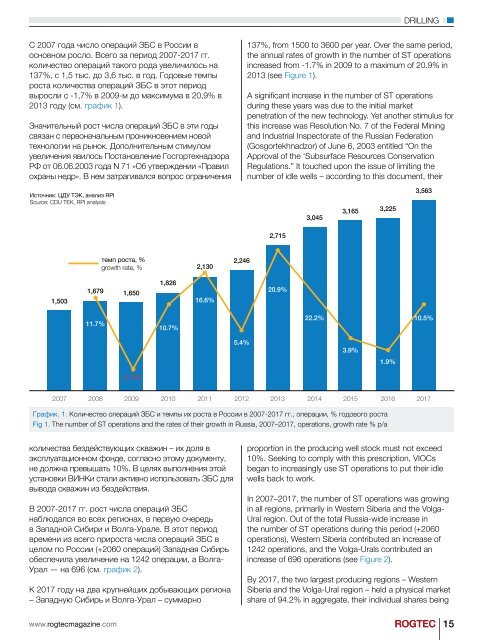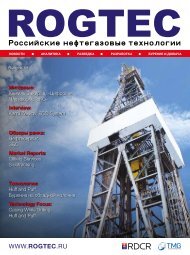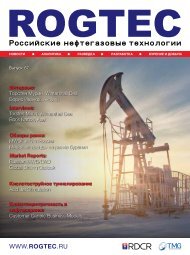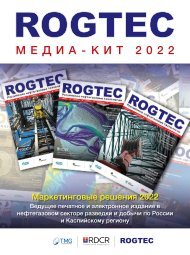ROGTEC Magazine Issue 55
ROGTEC, Russian Oil and Gas Technologies, Magazine is Russia’s leading upstream oil and gas publication. Produced with the aim of being the leading, independent, technology based journal for the Russian, Caspian, CIS and Eurasia regions. Covering from exploration through to drilling, completion and production technologies the ROGTEC publication works hand in hand with the regional Operators like Lukoil, Rosneft, Salym Petroleum Development, Gazprom, Gazprom Neft and many other. ROGTEC - The Engineers choice!
ROGTEC, Russian Oil and Gas Technologies, Magazine is Russia’s leading upstream oil and gas publication. Produced with the aim of being the leading, independent, technology based journal for the Russian, Caspian, CIS and Eurasia regions. Covering from exploration through to drilling, completion and production technologies the ROGTEC publication works hand in hand with the regional Operators like Lukoil, Rosneft, Salym Petroleum Development, Gazprom, Gazprom Neft and many other. ROGTEC - The Engineers choice!
Create successful ePaper yourself
Turn your PDF publications into a flip-book with our unique Google optimized e-Paper software.
DRILLING<br />
С 2007 года число операций ЗБС в России в<br />
основном росло. Всего за период 2007-2017 гг.<br />
количество операций такого рода увеличилось на<br />
137%, с 1,5 тыс. до 3,6 тыс. в год. Годовые темпы<br />
роста количества операций ЗБС в этот период<br />
выросли с -1,7% в 2009-м до максимума в 20,9% в<br />
2013 году (см. график 1).<br />
Значительный рост числа операций ЗБС в эти годы<br />
связан с первоначальным проникновением новой<br />
технологии на рынок. Дополнительным стимулом<br />
увеличения явилось Постановление Госгортехнадзора<br />
РФ от 06.06.2003 года N 71 «Об утверждении «Правил<br />
охраны недр». В нем затрагивался вопрос ограничения<br />
137%, from 1500 to 3600 per year. Over the same period,<br />
the annual rates of growth in the number of ST operations<br />
increased from -1.7% in 2009 to a maximum of 20.9% in<br />
2013 (see Figure 1).<br />
A significant increase in the number of ST operations<br />
during these years was due to the initial market<br />
penetration of the new technology. Yet another stimulus for<br />
this increase was Resolution No. 7 of the Federal Mining<br />
and Industrial Inspectorate of the Russian Federation<br />
(Gosgortekhnadzor) of June 6, 2003 entitled “On the<br />
Approval of the ‘Subsurface Resources Conservation<br />
Regulations.” It touched upon the issue of limiting the<br />
number of idle wells – according to this document, their<br />
Источник: ЦДУ ТЭК, анализ RPI<br />
Source: CDU TEK, RPI analysis<br />
3,045<br />
3,165 3,225<br />
3,563<br />
2,715<br />
темп роста, %<br />
growth rate, %<br />
2,130<br />
2,246<br />
1,503<br />
1,679 1,650<br />
1,826<br />
16.6%<br />
20.9%<br />
11.7%<br />
10.7%<br />
22.2%<br />
10.5%<br />
5.4%<br />
3.9%<br />
1.9%<br />
-1.7%<br />
2007 2008 2009 2010 2011 2012 2013 2014 2015 2016 2017<br />
График. 1. Количество операций ЗБС и темпы их роста в России в 2007-2017 гг., операции, % годового роста<br />
Fig 1. The number of ST operations and the rates of their growth in Russia, 2007–2017, operations, growth rate % p/a<br />
количества бездействующих скважин – их доля в<br />
эксплуатационном фонде, согласно этому документу,<br />
не должна превышать 10%. В целях выполнения этой<br />
установки ВИНКи стали активно использовать ЗБС для<br />
вывода скважин из бездействия.<br />
В 2007-2017 гг. рост числа операций ЗБС<br />
наблюдался во всех регионах, в первую очередь<br />
в Западной Сибири и Волга-Урале. В этот период<br />
времени из всего прироста числа операций ЗБС в<br />
целом по России (+2060 операций) Западная Сибирь<br />
обеспечила увеличение на 1242 операции, а Волга-<br />
Урал — на 696 (см. график 2).<br />
К 2017 году на два крупнейших добывающих региона<br />
– Западную Сибирь и Волга-Урал – суммарно<br />
proportion in the producing well stock must not exceed<br />
10%. Seeking to comply with this prescription, VIOCs<br />
began to increasingly use ST operations to put their idle<br />
wells back to work.<br />
In 2007–2017, the number of ST operations was growing<br />
in all regions, primarily in Western Siberia and the Volga-<br />
Ural region. Out of the total Russia-wide increase in<br />
the number of ST operations during this period (+2060<br />
operations), Western Siberia contributed an increase of<br />
1242 operations, and the Volga-Urals contributed an<br />
increase of 696 operations (see Figure 2).<br />
By 2017, the two largest producing regions – Western<br />
Siberia and the Volga-Ural region – held a physical market<br />
share of 94.2% in aggregate, their individual shares being<br />
www.rogtecmagazine.com<br />
<strong>ROGTEC</strong><br />
15















